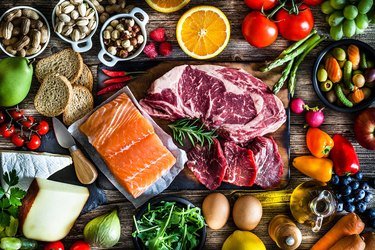1. Use Smaller Plates and Bowls
Research shows that people tend to eat more when they use larger plates and bowls. Opting for smaller dinnerware tricks your brain into thinking you’re consuming more food than you are. Smaller plates and bowls encourage you to fill them only with the appropriate portion size, which helps reduce overeating.
2. Follow Serving Size Recommendations
Nutrition labels provide valuable information about the appropriate serving sizes of packaged foods. Understanding the serving size allows you to avoid mindlessly consuming extra portions, which is common when we snack directly from a package. This is especially important for snacks like chips, crackers, or sweets, where serving sizes are often smaller than we realize.
3. Measure and Weigh Your Food
When starting out with portion control, measuring your food can help you understand how much you’re actually eating. A kitchen scale or measuring cups can help ensure you’re eating the appropriate amounts. Over time, you’ll likely develop an intuitive sense of how much food is the right portion for you.
4. Understand Common Portion Sizes
Understanding what constitutes a “standard” portion size is essential for practicing portion control. Here are some basic guidelines:
- Protein: A serving size of meat, fish, or poultry should be around 3–4 ounces, roughly the size of the palm of your hand (without the fingers). For plant-based proteins like beans, tofu, or legumes, aim for ½ to 1 cup per serving.
- Carbohydrates: A serving of carbohydrates like pasta, rice, or potatoes is about ½ cup of cooked food or the size of a fist. One slice of bread or a small baked potato also counts as one serving.
- Vegetables: Non-starchy vegetables should take up the largest portion of your plate. A serving of vegetables is generally 1 cup of raw veggies or ½ cup of cooked vegetables. You can eat these freely, as they are high in fiber and nutrients while being low in calories.
- Fruits: A serving of fruit is typically about the size of your fist or one small piece (like an apple or banana). Whole fruits are preferable to fruit juices as they contain fiber and fewer added sugars.
- Fats: Healthy fats (such as avocado, olive oil, nuts, or seeds) should be consumed in moderation. A serving size is typically 1 tablespoon of oil or nut butter, or a small handful of nuts or seeds.
5. Portion Out Snacks Ahead of Time
It’s easy to overeat when snacking directly from a bag or container. Instead, portion out snacks in advance into smaller servings. Use small bags or containers to measure out single-serving sizes. This keeps you from mindlessly consuming more than you intended.
6. Slow Down and Practice Mindful Eating
Mindful eating involves paying full attention to the act of eating, savoring the textures, flavors, and smells of the food, and listening to your body’s hunger and fullness cues. Eating slowly can help prevent overeating, as it takes around 20 minutes for your brain to register that you’re full.
Portion Control Challenges and How to Overcome Them
While portion control is incredibly beneficial, it can be difficult to implement consistently. Here are some common challenges and solutions:
Eating Out
Restaurants often serve large portions, which can make it hard to control how much you’re consuming. Here are some tips:
- Ask for a smaller portion: Many restaurants offer “half” or “small” portions upon request.
- Share meals: Share larger dishes with a dining companion to avoid excess food.
- Take leftovers home: If you do receive a large portion, ask for a to-go box immediately and pack up half of the meal before you even begin eating.
- Be mindful of appetizers and sides: These often come in larger portions than necessary, so consider splitting or skipping them.
Social Situations
Social gatherings and celebrations often involve large amounts of food. The key is moderation:
- Choose your favorites: Instead of sampling everything on the buffet table, select a few items you truly enjoy and take smaller portions.
- Engage in conversation: Eating slowly and chatting with others can help you stay mindful and prevent overeating.
- Control your environment: If you’re at home, don’t leave large serving dishes on the table, as they can tempt you to go for seconds.
Hunger and Emotional Eating
Sometimes we eat because we are bored, stressed, or emotional, rather than because we are hungry. Here’s how to combat it:
- Address emotional triggers: Recognize when you’re eating due to emotional reasons and find healthier ways to cope with stress, like going for a walk or engaging in a hobby.
- Drink water: Sometimes thirst is mistaken for hunger. Drink a glass of water and wait a few minutes before reaching for a snack.
- Practice portion control with “trigger” foods: If you tend to overeat certain foods, portion them out in advance and limit your access to them.
Benefits of Portion Control
- Sustained Weight Loss or Maintenance: Portion control helps to manage your calorie intake without needing to follow restrictive diets. It allows you to enjoy a variety of foods in moderation and maintain a healthy weight in a sustainable way.
- Improved Health Metrics: Portion control can help lower the risk of chronic conditions like type 2 diabetes, heart disease, and high blood pressure. By managing your food intake, you can maintain better blood sugar levels, cholesterol levels, and overall cardiovascular health.
- Better Relationship with Food: By focusing on moderation rather than restriction, you can develop a healthier and more enjoyable relationship with food. This can reduce feelings of guilt or stress around eating, as you’ll no longer be focused on “good” and “bad” foods.
- Increased Energy and Productivity: Proper portion sizes ensure that your body is fueled appropriately throughout the day. When you avoid overeating, you feel more energized and focused, enhancing productivity and overall well-being.
Conclusion: The Long-Term Impact of Portion Control
Portion control is not a temporary fix; it’s a long-term approach to developing healthier eating habits. It’s about creating balance and mindfulness in your eating habits rather than relying on extreme diets or fad trends. By understanding your body’s needs and taking the time to practice portion control, you can manage your weight, boost your energy levels, and improve your overall health in a sustainable way. With a little practice, portion control can become second nature, helping you live a healthier, more mindful life.
































Pingback: viagra 50 mg coupon